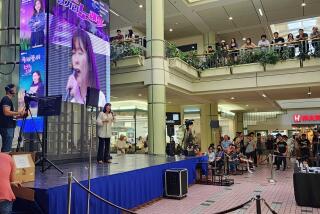The spirit rises within a swirl of silk
- Share via
Many skilled and gracious women presented traditional dances exploiting the artful manipulation of sleeves, scarves or cloth pom-poms during a12-part program titled “The Spirit of Korean Dance and Music” at the John Anson Ford Amphitheatre on Saturday. But only Um Ox-Ja made fabric into a living thing, something to be lovingly touched as if it were another person -- or, perhaps, the memory of someone conjured up in a length of flowing white silk.
A veteran dancer officially designated as a Living National Treasure, Um performed “Won-Hyang Sal Poori Choom,” a solo gravely contemplative yet full of exquisite expressive passages: a moment, for instance, when she left the long rectangular scarf on the floor behind her, then turned to look at it, hover over it and finally sink down beside it as if surrendering herself.
Traditional Korean dance emphasizes an extraordinary lightness and liquidity in the shoulders -- as if they lift the whole body at each breath -- with tiny pulses accenting the lyric arm motion flowing from them. The distinguished soloists (many of them guests from South Korea) who proved especially gifted in projecting this technique included Kim Ji-Won in the drum dance “So-Go Chom,” Lee Chun-Ja in the court ensemble “Tae Pyung Moo,” and Lim Mi-Ja in “San Jo Moo,” in which the choreography seemed to mirror subtle shifts in the dancer’s thoughts and feelings.
Extroversion triumphed when Jung Myeong-Ja danced while playing a two-sided drum hung at her waist (“Jin-Do Buk Choom”); when Song Jin-Soo used pom-poms to carve a pathway in space (“Je Jeon Choom”); when Hong Eun-Joo curled silken sleeves in the air like a master calligrapher (“Seung Mu”); and most of all when Baek Sun-Hee shook a cluster of golden bells, swirled a fan, swung five flags overhead and jumped with great vivacity (“Moo-Dang Choom”).
The locally based Jung Im Lee Korean Dance Academy contributed the most spectacular piece on the program: “Three Drum Dance,” featuring 20 young percussionists, nine of whom danced inside drum alcoves, whirling from one instrument to another in sync with everyone else.
Except for the drum dances, taped music served as accompaniment -- sometimes ruinously when distorted by over-amplification. Happily, a segment devoted to folk songs not only boasted live music but also an appearance by Lee Choon-Hee, another Living National Treasure and a singer of potent charm and sweetness.
Signs and an announcement at the Ford promised a 90-minute performance (no intermission), though the event lasted about an hour longer. Besides the Ford program booklet, a lavish souvenir program and onstage narration provided essential data about the pieces and performers. But nobody explained why males were utterly banished from the proceedings (except for techies and Lee Choon-Hee’s two musicians).
Moreover, nobody mentioned the array of exciting traditional Korean idioms that would have lent more variety to the program -- the gymnastic farmers’ bands, for example. Or the many, many masked dance-dramas from various regions of the country, with their pithy comic insights into human foibles.
Clearly, the spirit of Korean music and dance embraces a much wider range of experiences than “The Spirit of Korean Music and Dance” offered on Saturday. But the concentration on classical dancing inspired by overlapping religious traditions did serve as a reminder to our secular society of how dance can be a sublime expression of spirituality.
A program greeting written by In Taek Park, publisher of the Korea Daily (one of the evening’s sponsors), spoke of the event as a cultural transfusion for immigrants “that will encourage the Korean Americans’ exhausted lives.”
His point is probably arguable -- you could also say Korean Americans seem the opposite of exhausted -- but who cares when the pretext helped put all this antique, soulful splendor in the heart of Hollywood.
More to Read
The biggest entertainment stories
Get our big stories about Hollywood, film, television, music, arts, culture and more right in your inbox as soon as they publish.
You may occasionally receive promotional content from the Los Angeles Times.










